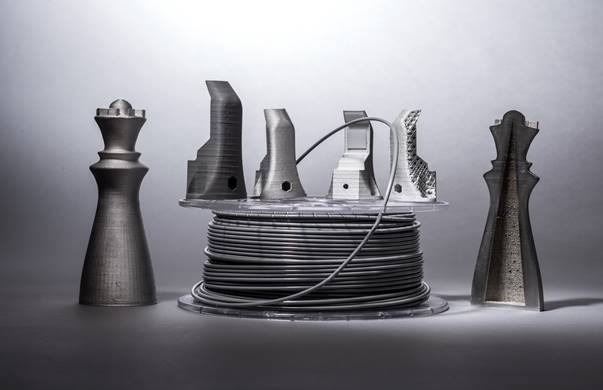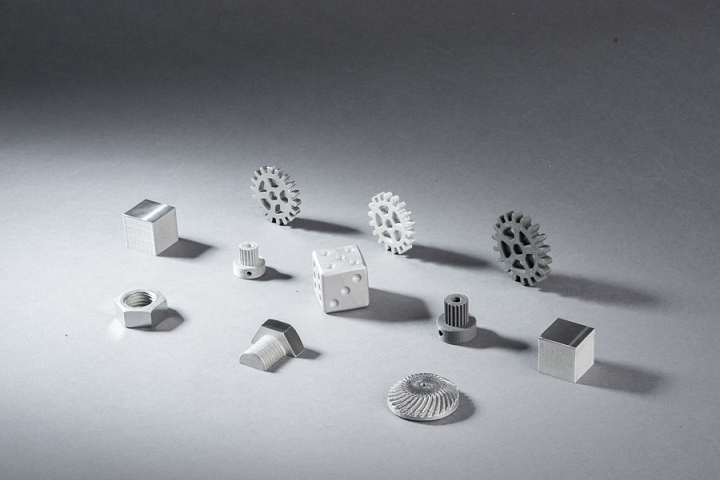MakerBot, a subsidiary of Stratasys (Nasdaq: SSYS) has announced that BASF Ultrafuse 316L Stainless Steel material is qualified for use with the MakerBot LABS Experimental Extruder1 for the MakerBot METHOD line of 3D printers. This makes it one of the few brands with systems explicitly qualified to use this metal 3D printing filament.
The MakerBot METHOD is unique in that it is designed for repeatability and consistency, in part due to its heated chamber. The MakerBot LABS GEN 2 Experimental Extruder opens up this series of printers to use metal filament, such as Ultrafuse 316L. It’s possible to achieve up to 96 percent of the density of pure stainless steel.
The material is said to be particularly useful for making jigs and fixtures, as well as end use parts. Examples include workholdings that will be exposed to high heat, high strength brackets for specialty machinery, and strong, lightweight, and wear-resistant robotic grippers.
 BASF’s Ultrafuse 316L – Metal filament for 3D printing stainless steel parts
BASF’s Ultrafuse 316L – Metal filament for 3D printing stainless steel partsBound metal printing filaments may represent a key method for introducing metal 3D printing to a wider audience at a lower cost. With them, users of desktop 3D printers can begin fabricating metal parts. Once a component is printed in something like Ultrafuse 316L, it must then be put through a debinding process and sintered in a furnace to obtain the final metal part.
This means that those wishing to print metal parts need not purchase a Metal X from Markforged, a Studio System from Desktop Metal, or the ExOne Metal Designlab. They can instead buy a spool of metal filament and begin using their desktop machines, which typically require specialty extruder nozzles for handling abrasive filaments.
At the moment, there are only very few manufacturers of such materials on the market. On one side, The Virtual Foundry produces a wide variety of metal (and ceramic) filaments but lacks the reach and financial backing of other materials companies. In contrast, BASF is the world’s largest chemical company and, so far, has only one metal 3D printing filament.
 Metal parts made with BASF Ultrafuse 316LX stainless steel filament by FFF.
Metal parts made with BASF Ultrafuse 316LX stainless steel filament by FFF.However, processing metal filaments is something that requires special equipment that may require some substantial capital investment. It’s worth noting that The Virtual Foundry states that debinding occurs during the sintering process and, therefore, no debinding step is required. The Virtual Foundry also offers low-cost kilns. How its materials compare to Ultrafuse is another story.
To get around the overhead investment needed for processing parts made with Ultrafuse, filament resellers like MatterHackers make it possible to connect with a service through them. Similarly, The Virtual Foundry works with Sapphire3D, who will process prints for customers, as well. Additionally, those interested in metal 3D printing filaments can have parts made by BASF subsidiary Sculpteo.
SmarTech Analysis predicts that bound metal technologies are now expected to achieve close to twice the growth rate than the overall metal AM market over the next ten years. This author is just waiting for BASF to release new materials and also a series of service providers who rely solely on printing and processing parts made with metal 3D printing filament to emerge and potentially disrupt the market.
Subscribe to Our Email Newsletter
Stay up-to-date on all the latest news from the 3D printing industry and receive information and offers from third party vendors.
Print Services
Upload your 3D Models and get them printed quickly and efficiently.
You May Also Like
Nikon SLM Solutions Sells SLM 500 to Primary Weapon Systems to Expand Suppressor Production
Primary Weapons Systems (PWS) is a Boise, Idaho-based manufacturer of suppressors, firearms, and related components. A subsidiary of Vigilant Gear and a sister company to aftermarket Glock slide manufacturer Lone...
3DPOD 261: Tooling and Cooling for AM with Jason Murphy, NXC MFG
Jason Murphy´s NXC MFG (Next Chapter Manufacturing) is not a generalist service; instead, the company specializes in making tooling. Using LPBF and binder jet, the company produces some of the...
HP and Firestorm Labs Form Partnership to Use Multi Jet Fusion 3D Printers in Deployable Factories
HP Inc., maker of a range of additive manufacturing (AM) solutions including the Multi Jet Fusion (MJF) ecosystem, has announced a partnership with Firestorm Labs, a developer of containerized, deployable...
3D Printing News Briefs, July 2, 2025: Copper Alloys, Defense Manufacturing, & More
We’re starting off with metals in today’s 3D Printing News Briefs, as Farsoon has unveiled a large-scale AM solution for copper alloys, and Meltio used its wire-laser metal solution to...
































